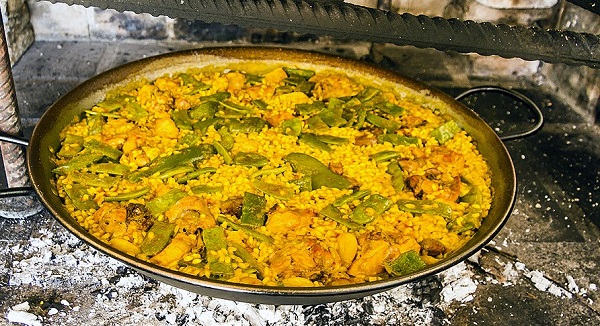Wine Pairing
Paella Valenciana

Paella is a Spanish rice dish from Valencia.
A typical Paella contains Rice, Chicken, Rabbit, Chorizo, Beens, Bell Pepper, and Saffron.
Pairing Suggestions
Tempranillo (Spain)
Garnacha (Spain)
Valpolicella (Italy)
Dolcetto (Italy)
Pinot Noir (World)
Merlot (World)
Other Excellent Alternatives
Rioja Rosado (Spain)
Cava Brut (Spain)
Metodo Classico (Italy)
Champagne (France)
Crémant (France)
White Alternatives
Godello (Spain)
White Rioja (Spain)
White Bordeaux (France)
Chardonnay (France)
Soave Classico (Italy)
Description
Paella is a Rich Dish.
It should be paired with a slightly chilled young and fruity red wine.
If you prefer a white wine, you should go for a wine that has spent some time in a barrel.
Avoid Heavy Oak!
Paella does not work very well with heavy oak.
Go Local if You Can

Let local wines complement the flavors of local food.
Pairing local wine with local food will enhance the dining experience by harmonizing the characteristics of the wine with the ingredients and cooking styles of the region:
Terroir
The environmental factors, soil, climate, and topography, that influence the characteristics of a wine, represent the Wine Terroir of a region. The ingredients, flavors, and cooking techniques represent the Cuisine Terroir.
Culture and Tradition
Local wines are deeply intertwined with the culture and traditions of a region. Pairing them with local cuisine creates an authentic culinary experience. For example, if a region is known for its hearty, red meat dishes, a robust and full-bodied red wine from the region will enhance the dining experience.
Ask for Help
Let local chefs and winemakers collaborate to create innovative pairings that showcase the best of the region.
A good rule of thumb is to match the intensity of the wine with the richness of the meat for the best pairing experience.
Examples
Pairing Italian Chianti with traditional Tuscan dishes like Pasta with Ragu or Beef Fiorentina.
Enjoy a Red Burgundy with classic French dishes like coq au vin or boeuf Bourguignon.
Matching Spanish Rioja with Paella or Tempranillo with Tapas.